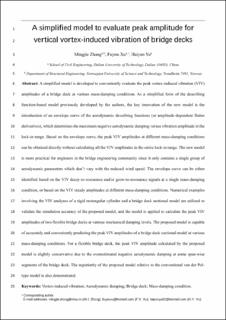| dc.contributor.author | Zhang, Mingjie | |
| dc.contributor.author | Xu, Fuyou | |
| dc.contributor.author | Yu, Haiyan | |
| dc.date.accessioned | 2021-03-25T14:11:10Z | |
| dc.date.available | 2021-03-25T14:11:10Z | |
| dc.date.created | 2020-10-21T11:58:35Z | |
| dc.date.issued | 2021 | |
| dc.identifier.citation | International Journal of Mechanical Sciences. 2021, 192 . | en_US |
| dc.identifier.issn | 0020-7403 | |
| dc.identifier.uri | https://hdl.handle.net/11250/2735572 | |
| dc.description.abstract | A simplified model is developed to conveniently evaluate the peak vortex-induced vibration (VIV) amplitudes of a bridge deck at various mass-damping conditions. As a simplified form of the describing function-based model previously developed by the authors, the key innovation of the new model is the introduction of an envelope curve of the aerodynamic describing functions (or amplitude-dependent flutter derivatives), which determines the maximum negative aerodynamic damping versus vibration amplitude in the lock-in range. Based on the envelope curve, the peak VIV amplitudes at different mass-damping conditions can be obtained directly without calculating all the VIV amplitudes in the entire lock-in range. The new model is more practical for engineers in the bridge engineering community since it only contains a single group of aerodynamic parameters which don't vary with the reduced wind speed. The envelope curve can be either identified based on the VIV decay-to-resonance and/or grow-to-resonance signals at a single mass-damping condition, or based on the VIV steady amplitudes at different mass-damping conditions. Numerical examples involving the VIV analyses of a rigid rectangular cylinder and a bridge deck sectional model are utilized to validate the simulation accuracy of the proposed model, and the model is applied to calculate the peak VIV amplitudes of two flexible bridge decks at various mechanical damping levels. The proposed model is capable of accurately and conveniently predicting the peak VIV amplitudes of a bridge deck sectional model at various mass-damping conditions. For a flexible bridge deck, the peak VIV amplitude calculated by the proposed model is slightly conservative due to the overestimated negative aerodynamic damping at some span-wise segments of the bridge deck. The superiority of the proposed model relative to the conventional van der Pol-type model is also demonstrated. | en_US |
| dc.language.iso | eng | en_US |
| dc.publisher | Elsevier | en_US |
| dc.rights.uri | http://creativecommons.org/licenses/by-nc-nd/4.0/deed.no | |
| dc.title | A simplified model to evaluate peak amplitude for vertical vortex-induced vibration of bridge decks | en_US |
| dc.type | Peer reviewed | en_US |
| dc.type | Journal article | en_US |
| dc.description.version | acceptedVersion | en_US |
| dc.source.pagenumber | 10 | en_US |
| dc.source.volume | 192 | en_US |
| dc.source.journal | International Journal of Mechanical Sciences | en_US |
| dc.identifier.doi | 10.1016/j.ijmecsci.2020.106145 | |
| dc.identifier.cristin | 1841144 | |
| dc.description.localcode | © 2020. This is the authors’ accepted and refereed manuscript to the article. Locked until 16/10-2022 due to copyright restrictions. This manuscript version is made available under the CC-BY-NC-ND 4.0 license http://creativecommons.org/licenses/by-nc-nd/4.0/ | en_US |
| cristin.ispublished | true | |
| cristin.fulltext | original | |
| cristin.qualitycode | 1 | |

